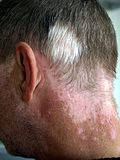Pigmentation disorders
From WikiLectures
Pigmentation disorders are diseases associated with an excess or lack of melanin, or the presence of another endogenous or exogenous pigment.[1]
Hyperpigmentation[edit | edit source]
Hyperpigmentation is an excess of melanin.
- Ephelides, freckles – are sharply demarcated, yellowish or brown spots several mm in size. Rarely, they can also appear on the lips and oral cavity. It belongs to dominantly inherited deviations
- Peutz-Jeghers syndrome – is an AD hereditary disease. It is manifested by intestinal polyposis and freckle-like pigmentation around the mouth and on the red lip.
- Chloasma uterinum (melasma) are large, sharply defined, yellowish to yellowish-brown spots. They appear symmetrically on the temples and faces of girls and women. occurrence is determined by hormones, they often appear during pregnancy.
- Poikilodermia Civatte is hyperpigmentation associated with telangiectasias. It occurs in middle-aged women on the lateral surfaces of the neck, probably after photodynamically acting substances.
Secondary hyperpigmentation[edit | edit source]
- after illnesses, mechanical, physical, chemical dermatitis, photodermatoses, psoriasis, lichen ruber, chronic eczema, atopic dermatitis, ...
Removal - various bleaching agents (unreliable) - hydrargium amidochloratum, hydrogen peroxide, ...
Hypopigmentation[edit | edit source]
Hypopigmentation is a lack of melanin.
- Leucoderma is secondary depigmentation at the site of healed skin disease manifestations. It usually retains the shape of the original efflorescences;
- lleukoderma psoriaticum, syphiliticum, …
- Albinism is an AR hereditary disorder of the tyrosinase enzyme metabolism associated with a total or partial absence of melanin.
- Vitiligo s a progressive chronic disease of unknown cause. It affects more women. Occurrence is often familial. It manifests itself as sharply defined white spots of various sizes, the edges of which have a "fan-like" hyperpigmentation. Hair may be bleached.
Dyschromia[edit | edit source]
Dyschromia is hyperpigmentation caused by pigments other than melanin.
- Hemosiderin pigmentation - hemosiderosis (capillaritis) is most often on the lower legs in varicose veins. It is a disease of unknown etiology manifested by itching, eczema and petechiae.
- Bile dyes - manifested as jaundice.
- Exogenously - argyrosis is a gray discoloration of mucous membranes after treatment with silver solutions. It first appears on the gingiva. Exogenous dyschromia also includes tattoos.
Links[edit | edit source]
Related articles[edit | edit source]
Source[edit | edit source]
- BENEŠ, Jiří. Studijní materiály [online]. ©2007. [cit. 12.1.2011]. <http://jirben2.chytrak.cz/>.
Reference[edit | edit source]
- ↑ PIZINGER, Karel. Dermatovenerologie. 1. edition. Plzeň : Euroverlag, 2012. ISBN 978-80-7177-985-8.





